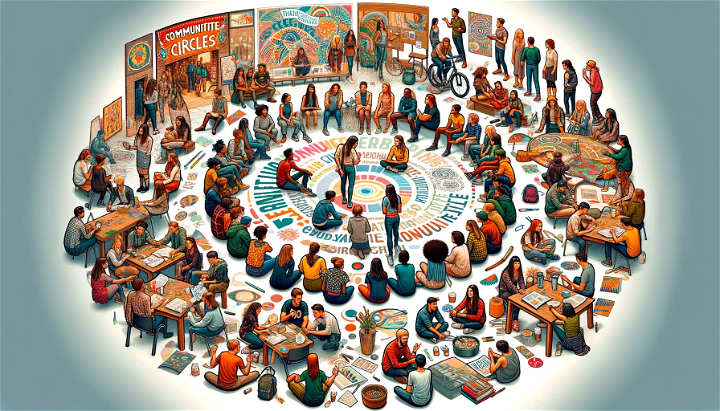The emergence of DIY (Do-It-Yourself) student circles has marked a significant shift in the educational landscape, blending the realms of learning and creativity. These student-led groups are not just extracurricular activities; they are dynamic communities where young minds converge to explore, innovate, and express themselves outside the rigid structures of traditional classrooms.
From technology and science to arts and environmental activism, DIY student circles embody the spirit of exploration and self-directed learning. They provide a unique opportunity for students to delve into their passions, learn new skills, and collaborate in a supportive environment.
The Rise of DIY Culture in Education

The Evolution of Student-Driven Learning
There has been a notable shift towards student-driven learning in recent years, with DIY student circles at the forefront of this movement. These groups reflect a growing recognition of the importance of hands-on, experiential learning to complement theoretical knowledge. In these circles, students are not passive recipients of information but active participants, exploring subjects that interest them. This approach fosters a deeper understanding of various subjects and cultivates critical skills like problem-solving, creativity, and teamwork. It’s a transformative experience that empowers students to take charge of their learning journey.
Benefits of Participating in DIY Circles
Participating in DIY circles offers multifaceted benefits. First and foremost, it enables skill development in a real-world context. Students learn practical skills that extend beyond the classroom, preparing them for future careers and endeavors.
Collaboration
Networking is another significant advantage; these circles connect students with peers, mentors, and professionals, expanding their horizons and opening up new opportunities. Additionally, engaging in creative and collaborative projects can enhance academic performance. Students in such groups often demonstrate improved concentration, time management, and a more profound interest in their studies.
The Role of Technology
Technology transforms DIY Circles by breaking geographical barriers and enabling online collaboration and knowledge sharing. Digital tools help document and disseminate project details, making them accessible globally, thus enriching the DIY community experience.
Promoting Creative Thinking
DIY Circles emphasize real-world problem-solving, encouraging students to devise practical solutions. This method enhances critical thinking and innovation, connecting academic theories with real-world applications. It also fosters a sense of social responsibility among students.
Real-World Problem Solving
DIY Circles focus on real-world problems, prompting students to develop practical solutions. This approach sharpens critical thinking and innovation skills, bridging the gap between theory and practice, and instills a sense of social responsibility in students.
Critical Components of Successful DIY Student Circles
Leadership and Organization
The success of a DIY student circle largely hinges on effective leadership. Leaders, who are typically students themselves, need to possess a blend of organizational skills, motivational prowess, and emotional intelligence. They are responsible for setting goals, planning activities, and ensuring every member feels included and valued. Good leadership in these circles keeps the group focused and efficient. It fosters a positive, productive environment where members feel empowered to contribute and grow.
Diversity and Inclusivity
A hallmark of successful DIY circles is their commitment to diversity and inclusivity. These groups thrive on the varied perspectives and skills of members from different backgrounds. An inclusive circle enhances the learning experience and promotes student empathy, respect, and cultural awareness. It’s a microcosm of the global community, preparing students for a world where collaboration across diverse groups is essential.
Resources and Support
Access to resources – materials, space, or mentorship – is crucial for developing DIY student circles. Support can come from various sources: educational institutions may provide space and funding; local businesses or alumni could offer materials and expertise; online platforms can be used for knowledge sharing and networking. This support is vital in enabling these groups to realize their projects and ambitions. Students may also find support in cases where they feel overwhelmed with their academic assignments. They can use assistance with essay writing by WritePaperForMe, which can help them resolve their academic challenges.
Case Studies: Successful DIY Student Circles
- Tech Innovators Group: This circle brings together students passionate about technology. They collaborate on coding, robotics, and app development projects, often participating in hackathons and competitions. The group hones technical skills and fosters entrepreneurial thinking and innovation.
- Artists’ Collective: Here, art enthusiasts gather to share techniques, critique each other’s work, and organize exhibitions. Workshops range from traditional painting to digital art, providing a broad spectrum of creative exploration. This collective is not just about honing artistic skills; it’s a space where students express themselves and learn the value of art in society.
- Eco-Warriors Club: Focused on environmental sustainability, this group engages in projects like campus recycling initiatives, community clean-ups, and awareness campaigns. It’s a platform for students to channel their environmental passion into actionable change, fostering environmental stewardship and community engagement.
Challenges and Solutions in DIY Student Circles
Overcoming Resource Limitations
Resource limitations are a common challenge for DIY circles. However, these groups often exhibit remarkable ingenuity in overcoming such constraints. These groups manage to sustain their activities through crowdfunding, partnerships with local businesses, and leveraging digital platforms for resources. This resourcefulness also teaches students valuable lessons in adaptability and innovation.
Maintaining Engagement and Momentum
Regular meetings, exciting and meaningful projects, and clear communication are essential to keep members engaged and maintain momentum. Leaders are crucial in ensuring that each member is involved and that the group’s activities align with their interests and goals. Celebrating successes, however small, also helps in keeping the group motivated and focused.
Navigating Group Dynamics
Managing group dynamics is critical. Effective communication, conflict resolution skills, and precise group norms can help navigate the challenges of working in diverse groups. Leaders must be equipped to handle interpersonal issues sensitively and effectively, ensuring a harmonious and productive environment.
Conclusion: The Future of DIY Student Circles
As we look towards the future, DIY student circles are poised to play an increasingly significant role in education. These groups not only complement formal learning but also prepare students for the challenges and opportunities of the real world. They are breeding grounds for innovation, collaboration, and personal growth. DIY student circles will undoubtedly be at the forefront as educational paradigms evolve, shaping tomorrow’s leaders, innovators, and creators.




